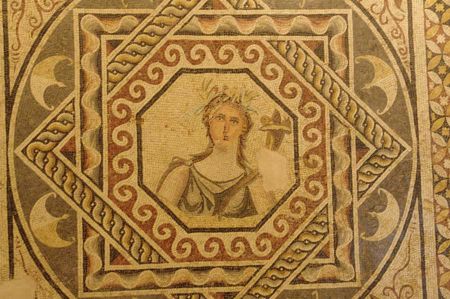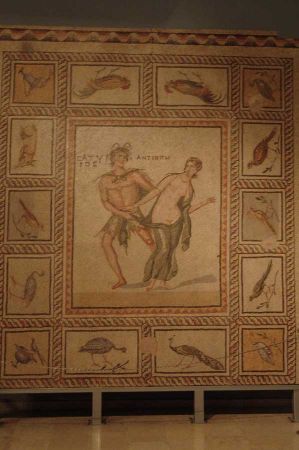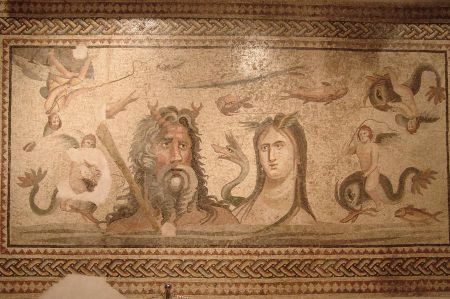Submerged in the floods of the Euphrates: Zeugma
- Written by Portal Editor
A few kilometres north of the newly built Birecik dam, two larger settlements faced each other on the banks of the Euphrates in ancient times: Apamea on the left and Seleukeia / Zeugma on the right bank.
Apamea and Seleukeia were founded by Seleucus I Nicator in the 3rd century BC. He had built a pontoon bridge across the river and turned Seleukeia into a commercial and administrative centre. The important crossing of the Euphrates was an important stage on the Silk Road. In addition to the economic, cultural exchange between the West and the Eastern cultures took place here.
Zeugma a trading centre and military station on the eastern border of the Roman Empire

In its heyday, the city is said to have had 70,000 residents. In 256 AD, the city was conquered, destroyed and cremated by the Sassanids. Collapsing house walls, possibly also as a result of an earthquake and natural erosion, have filled up the Roman city districts and covered them with a layer of earth up to 6m high. Today's findings suggest that the city was abandoned after the Sassanid invasions and has since fallen into disrepair.
Below the rubble, wonderful mosaics have been preserved in the elegant Roman villas on the riverbank, which aroused today's interest in this ancient city. In a newly built museum in Gaziantep, inaugurated in 2011, which is exclusively reserved for the frescoes and mosaics of Seleukeia / Zeugma, the treasures are exhibited in a very clear and impressive way.
Magnificent mosaics on the banks of the Euphrates

The excavations turned out to be arduous. A lack of money and initially little public interest hindered a systematic recording of the finds. Treasure robbers became active and stole numerous mosaics, took them down and left irreparable damage behind.
A special fate befell two mosaic fragments that were found on the terrace of a villa and that were stolen in 1965. The empty areas in the middle part of the mosaic that was exhibited in Gaziantep were, in terms of shape, filled with the representation of two people. After detailed stylistic and formal studies of the shapes and colours of the stones of the portraits and the drapery, the conclusion was drawn that the pair was exhibited in the Menil Collection House of Rice University in Houston / Texas and which, it was assumed, belonged to the particular Vil-la of Zeugma. It is the representation of Metiox and Parthenope, a mythological couple in love. Metiox can be identified by a mosaic inscription, the female figure initially lacked any means of identification, only the three letters PAR in the original mosaic in Gaziantep gave a small hint.
A particularly painful loss was the destruction of a large, 11-person mosaic depicting the wedding of Dionysus with a large retinue. In the centre of the mosaic, the wedding couple sat on a throne, offering a drink to Eros, the god of love. On the left is a woman spinning wool and on the right two women bring a box with presents to the wedding couple. On the left edge is a figure who drinks from a bowl, and an Aphrodite with a torch in an attitude as we know it from the frescoes of Pompeii. On the right you can see two flute players with their instruments. Today we only know this magnificent floor mosaic from the pictures taken when it was discovered. Large parts were stolen in June 1998 and have since disappeared. (see pictures).
Turkish archaeologists from Gaziantep start excavation
The history of the emergency excavations on the Euphrates is more than adventurous, because even when it was announced that the Birecik dam would be completed in 2000, interest in the mosaics was rather restrained. In 1994 the archaeologists from Gaziantep alerted the international archaeologists and called for assistance with the emergency excavations, but there was no response and the Turkish Ministry of Culture was just willing to provide very sparse support. Necessary excavations could not be carried out due to lack of money. In 1995, on the initiative of the French Ministry of Foreign Affairs, concrete support for the excavations was provided, which lasted until 1999. In the year 2000 the water level of the Euphrates reached the area of the Roman villas and it seemed as if irretrievable treasures would be lost when the river should reach its final level.
New museum in Gaziantep opened in 2011
Today the villas are named after the figurative representations found in them. It cannot be the place here to present the abundance of mosaics, just one thing should be mentioned.
In the villa of Poseidon, the viewer is overwhelmed by the powerful depiction of the sea god on a golden chariot, pulled by two silver horses, which rides head-on towards the viewer. Below that are Oceanos and Thetis, in the midst of an abundance of different sea creatures. The well-preserved depiction of the god Dionysus was found in the same villa as he drives into the picture from the left on a chariot pulled by two panthers and steered by the goddess of victory Nike. You can also marvel at the ornamental ribbons, which in their unbelievable variety encompass almost all the patterns of late antique ornamental art.
Please read as well:
